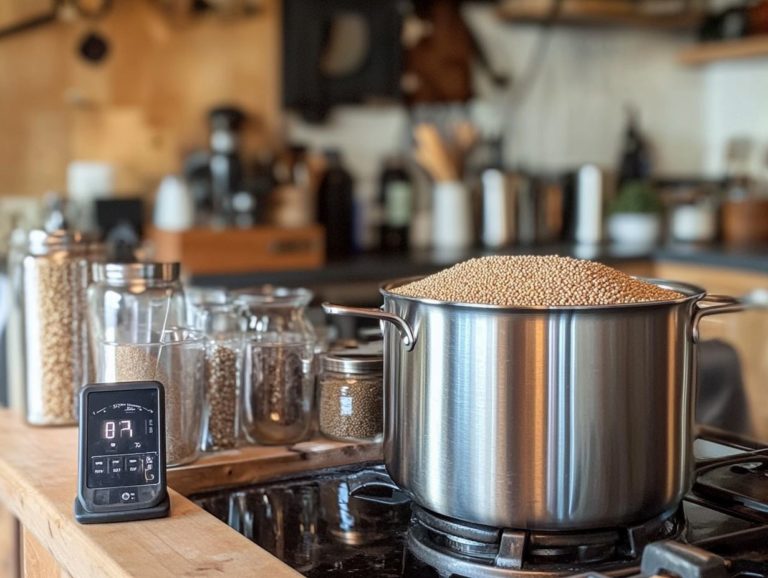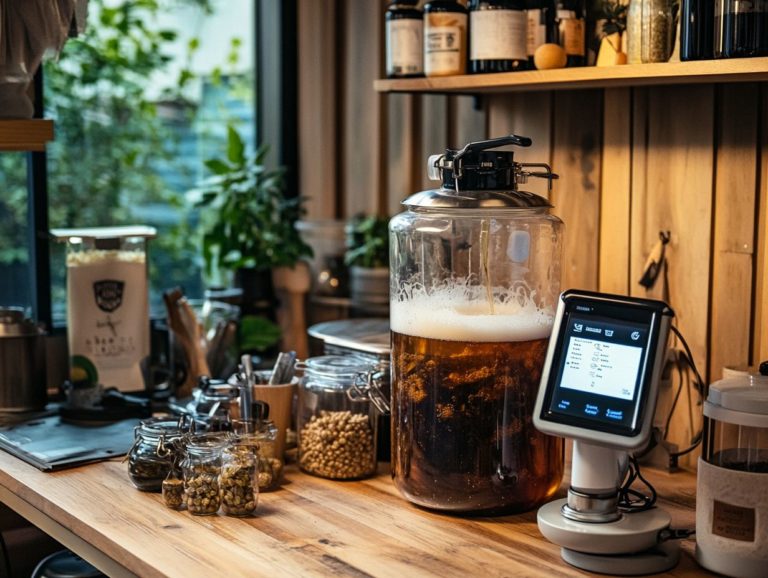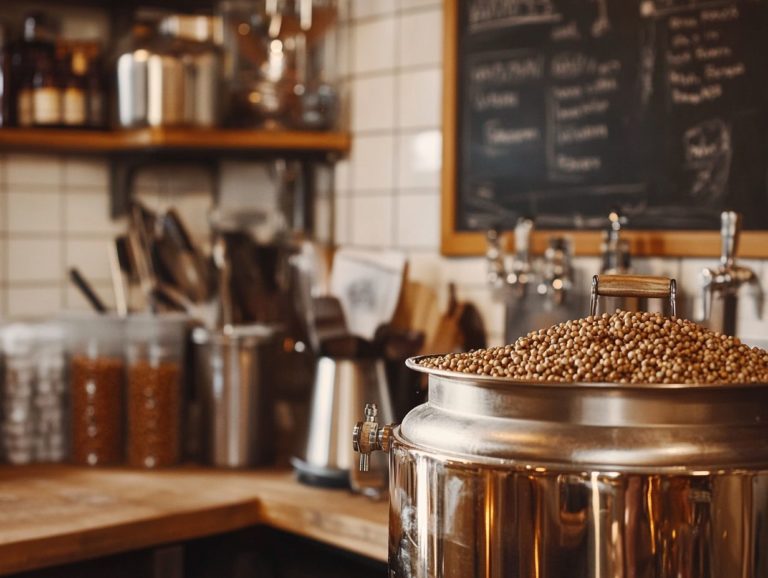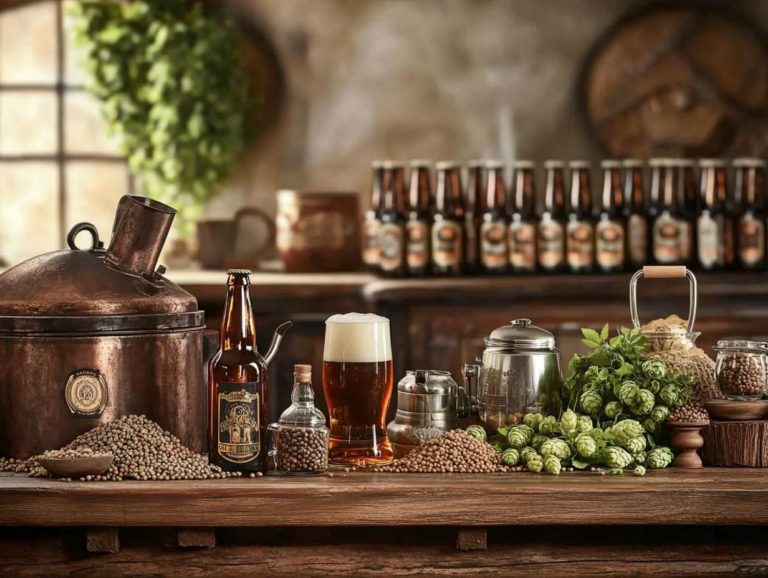The Importance of Recipe Consistency
In the cooking world, recipe consistency transcends mere professional standards; it embodies the essence of any successful kitchen. Whether you re a passionate home cook or a seasoned chef, maintaining a consistent taste and quality is crucial it can truly make or break your dishes. For instance, serving up a restaurant meal or a family favorite like frozen macaroni requires the same attention to detail. Don t let inconsistency ruin your culinary reputation!
This article delves into the significance of recipe consistency, highlighting its impact on customer satisfaction and the protection of your brand’s reputation. You ll discover practical tips for achieving consistency, understand the consequences of standards slipping, and explore strategies for improvement. The use of recipe management software can also be a game-changer in maintaining standards.
Prepare to uncover the key ingredients to culinary success!
Contents
- Key Takeaways:
- Why Is Recipe Consistency Important?
- 4. Cost Efficiency
- How To Achieve Recipe Consistency?
- Maintaining Recipe Consistency for Culinary Success
- What Are The Consequences Of Inconsistent Recipes?
- How To Improve Recipe Consistency?
- Continuously Monitor and Adjust Recipes
- Frequently Asked Questions
- Why is recipe consistency important?
- What impact does kitchen efficiency have on recipe consistency?
- How does kitchen performance impact culinary excellence?
- How does recipe visibility influence kitchen performance?
- What role do cooking utensils play in recipe consistency?
- How do ingredients affect recipe consistency?
- Can inconsistent recipes lead to food safety issues?
- What measures can be taken to handle food allergies?
- How do portion sizes affect food safety?
- How important is employee training in maintaining recipe consistency?
- How does recipe consistency affect cost and waste?
- How does recipe consistency impact customer experience?
- What is the impact of portion size on recipe consistency?
- What factors can contribute to inconsistent recipes?
- Can inconsistent recipes lead to food safety issues?
- What role do suppliers play in recipe consistency?
- How do ingredient quantities affect recipe consistency?
- How do recipe components interact to influence consistency?
- Are there software solutions to assist in recipe management?
- How can recipe consistency be achieved?
- What is the importance of regular recipe testing?
- How do cooking instructions help in achieving consistency?
- How do recipe developers contribute to consistency?
- Why is it important for restaurants to have a consistent menu?
- How do portion sizes affect quality experience?
- How does recipe management contribute to menu compliance?
- What are the benefits of recipe management software?
- What is the role of recipe accuracy in cooking culture?
- How does the USDA impact food quality?
- How Can Culinary Excellence Be Maintained in a Foodservice Operation?
Key Takeaways:
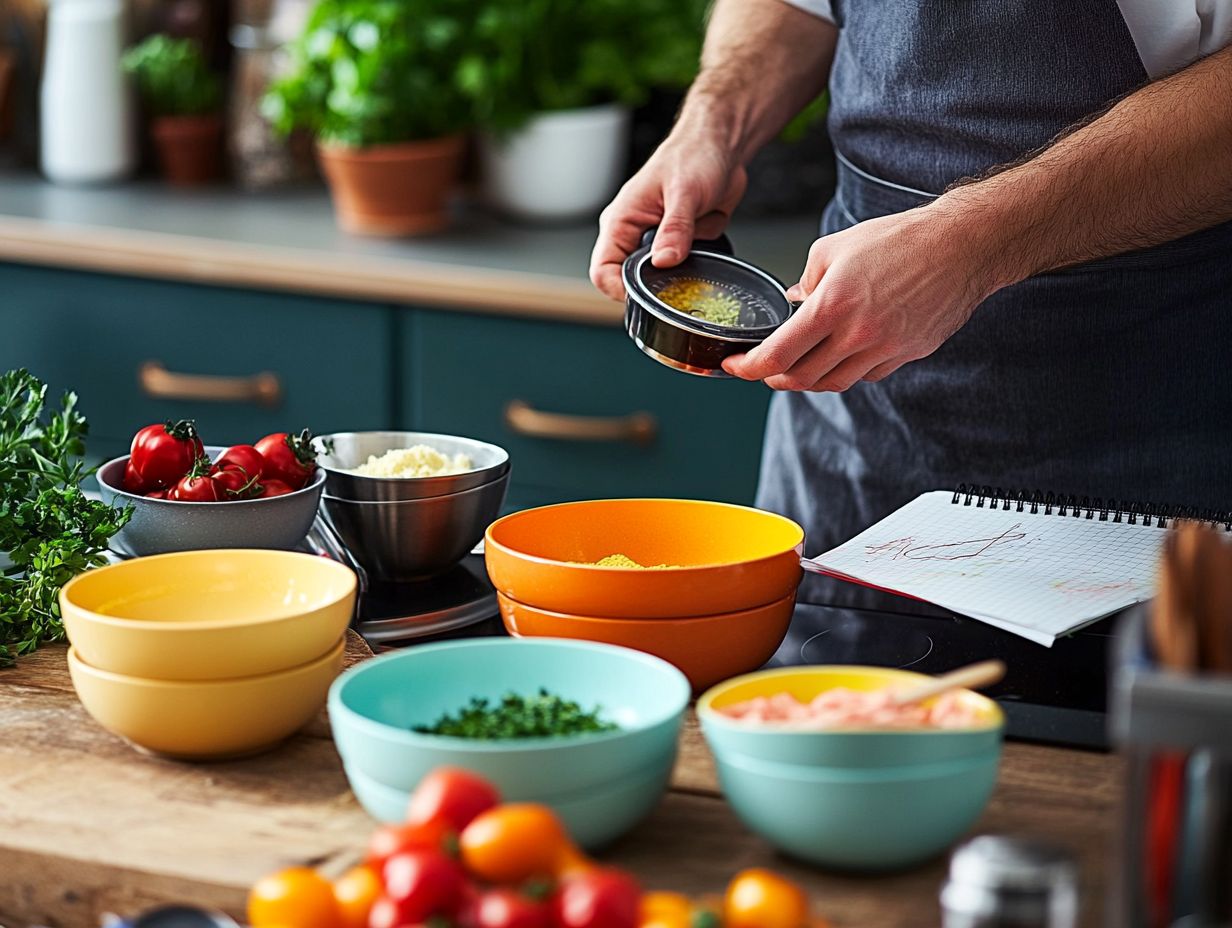
- Consistent recipes ensure a uniform taste and quality, satisfying customers and strengthening brand identity.
- Accurate measurements, standardized ingredients, training staff, and regular quality checks are key to achieving recipe consistency.
- Inconsistent recipes can lead to dissatisfied customers, damaged brand reputation, and wasted resources.
Why Is Recipe Consistency Important?
Recipe consistency is paramount in the cooking world, as it guarantees that every dish presented aligns with established standards of taste and quality, ultimately elevating customer satisfaction. Digital distribution of standardized recipes ensures that all restaurant staff are on the same page.
In a foodservice operation, adhering to consistent recipes ensures menu compliance, enabling restaurants to deliver a predictable culinary experience that bolsters their brand identity and reputation. Recipe management tools can help track recipe costs and streamline operations. This consistency cultivates trust among customers, who anticipate a standard flavor profile in their meals.
By adopting robust recipe management practices, including the use of standardized recipes, you can streamline kitchen operations and significantly enhance overall efficiency. This approach also supports dietary requests such as gluten-free or vegan options.
1. Consistent Taste and Quality
Consistent taste and quality are essential when it comes to serving up great meals that meet your expectations every single time.
To achieve this level of reliability, kitchens need to focus on several key components, starting with thorough recipe testing to refine the flavor profile of each dish. This process not only standardizes portion sizes but also allows chefs to experiment with variations in ingredient quality, ensuring that every meal aligns with your desired standards. Correct usage of cooking utensils is also crucial for consistency.
Utilizing fresh, high-quality ingredients is crucial for maintaining flavor consistency, while mastering cooking techniques adds another layer of precision whether it’s about temperature control, timing, or preparation methods. All of these elements work together in harmony to elevate the overall food quality, making each dining experience truly memorable.
2. Customer Satisfaction
Customer satisfaction relies heavily on your ability to serve meals that not only meet but exceed expectations in terms of quality and consistency.
When diners can consistently count on their favorite dishes to taste just as delightful with every visit, it elevates their overall dining experience, instilling a sense of comfort and familiarity. This reliability cultivates deep-seated loyalty; patrons are far more inclined to return to establishments that consistently present exceptional meals. Consistency also positively impacts the customer experience and ensures food allergies are adequately managed.
Prioritizing food quality not only encourages positive feedback but also solidifies a robust reputation within the community. A restaurant renowned for its outstanding culinary standards stands to attract new customers while retaining existing ones, illustrating just how crucial consistency is to thriving in the dynamic world of dining.
3. Brand Identity and Reputation
A restaurant’s brand identity is deeply intertwined with its reputation for consistently delivering high-quality meals, which is essential for achieving long-term success in the restaurant industry.
When you choose to dine at a particular establishment, you expect that same delightful experience each time, and this expectation solidifies your loyalty. Take, for instance, a steakhouse renowned for its perfectly cooked ribeye; it can build a loyal customer base that eagerly returns for that unforgettable flavor.
Conversely, inconsistency in food quality can erode trust and tarnish the brand’s identity. Look at restaurants like In-N-Out Burger; they ve cultivated a cult following largely due to their steadfast commitment to core menu items, ensuring that each visit delivers satisfaction.
The connection between recipe consistency and public perception is crucial, influencing not just the dining experience but also customer loyalty and brand recognition. Recipe visibility is crucial in maintaining these standards.
4. Cost Efficiency
Maintaining recipe consistency not only elevates the quality of your dishes but also enhances cost efficiency in your kitchen operations by streamlining food preparation and managing resources effectively. Recipe management software, which helps you keep track of your recipes and ingredients, can play a significant role in this.
By ensuring that each dish is prepared with the same standardized ingredients and methods, you can significantly reduce food waste.
Precise measurements help limit excess, leading to more predictable inventory management. This predictability allows you to plan your menus and shopping lists with greater accuracy, ensuring that you make the most of your purchases. Proper recipe adjustments based on ingredient availability can also help manage food preparation costs.
As a result, your team can optimize ingredient usage, fully capitalizing on what you buy. Consistent recipes also simplify training for new kitchen staff, improving overall efficiency while preserving the desired taste and presentation.
In essence, these practices cultivate a more profitable and sustainable culinary environment and give your kitchen the power to thrive.
How To Achieve Recipe Consistency?
To keep your customers coming back, achieving recipe consistency is a must! Achieving consistency in your recipes demands a comprehensive approach that prioritizes precise measurements, the use of standardized ingredients, and extensive staff training. Recipe developers can play a crucial role in creating effective recipes that are easy to replicate.
This ensures that each dish not only meets but exceeds the established quality benchmarks, allowing you to deliver an exceptional dining experience every time.
1. Accurate Measurements
Accurate measurements are essential for achieving recipe consistency, ensuring that your ingredient quantities are precise and aligned with standardized recipes.
When you utilize a recipe checklist alongside reliable measuring tools, you streamline your cooking process while significantly enhancing the quality of your final dish.
Precision in the amount of flour, sugar, or spices can dramatically impact the texture and flavor, leading to consistent results every single time. Recipe accuracy is paramount for achieving consistency.
For example, too much salt can easily overwhelm a dish, while an insufficient amount of a critical ingredient can leave it tasting bland.
By adhering to a checklist and using measuring cups or scales, you cultivate mindfulness in your cooking process. This attention to detail results in meals that not only look appealing but also taste fantastic, capturing the true essence of culinary artistry.
Maintaining Recipe Consistency for Culinary Success
2. Standardized Ingredients
Utilizing standardized ingredients is crucial for maintaining consistency in your recipes. This ensures that flavor profiles and food quality remain uniform across different batches. For example, replacing a specific herb with another should be documented in the recipe variations section.
Choosing high-quality ingredients from reliable suppliers plays a significant role in achieving this consistency. When the products you use in your recipes are predictable in taste and texture, you can replicate your culinary creations with confidence. This is true whether you’re a seasoned chef or a passionate home cook.
Being mindful of ingredient quality allows you to make slight adjustments to your recipes without compromising the core flavor profiles. If a particular herb or spice is unavailable, substituting it with a similar variant can still produce a delightful outcome.
By prioritizing quality and understanding how to adapt your recipes, you can consistently achieve remarkable results.
3. Proper Training and Communication
Proper training and communication among your kitchen staff are essential to ensure everyone understands and follows recipe instructions. This is critical for maintaining consistency.
When your employees receive thorough training, they are far more likely to execute tasks accurately. This minimizes the risk of errors and elevates the quality of the dishes you serve.
Implementing effective communication methods, such as regular team meetings and clear signage in the kitchen, fosters a collaborative environment. This atmosphere encourages each staff member to ask questions or share suggestions.
By embracing these practices, you streamline kitchen operations and foster a more efficient workflow. Ultimately, this bolsters the overall success of your culinary establishment.
4. Regular Quality Checks
Conducting regular quality checks is crucial for success! This practice helps ensure recipe consistency and allows you to identify discrepancies in food safety and quality before serving.
By systematically implementing these checks, you can uphold the high standards vital to exceptional dining experiences. Quality checks include visual inspections, taste tests, and strict adherence to food safety protocols.
Using a comprehensive recipe checklist ensures precision and consistency in recipes.
These procedures cultivate a culture of excellence where you and your kitchen staff remain vigilant against potential flaws. This proactive approach allows you to refine flavors and techniques, ultimately resulting in a delightful dining experience.
By incorporating standardized recipes, you can further ensure recipe consistency throughout your foodservice operation.
What Are The Consequences Of Inconsistent Recipes?
The consequences of inconsistent recipes can be profoundly detrimental to your restaurant. You may face decreased food quality, which can lead to customer dissatisfaction and increased recipe costs.
This poses a significant risk to your brand’s reputation, as diners expect reliability in their meal experiences. Maintaining consistency in your recipes is essential for nurturing trust and loyalty among your patrons.
Take a moment to evaluate your recipe management your reputation depends on it!
In the highly competitive restaurant industry, consistency in food preparation is crucial for maintaining customer satisfaction and loyalty. Here are some key areas where inconsistency can negatively impact your establishment:
1. Inconsistent Taste and Quality
Inconsistent taste and quality can significantly diminish your restaurant’s dining experience, leaving customers frustrated when they anticipate a specific flavor profile with each visit.
Variations in recipe execution can lead to notable discrepancies in the final dish, affecting everything from texture to aroma. For instance, if a chef changes the amount of spices or alters the cooking time, those seemingly minor adjustments can result in a dish that tastes completely different from what a loyal customer remembers. Moreover, using inconsistent ingredient quantities can lead to unpredictable portion sizes that disappoint guests.
A case study involving a beloved pizza place revealed that their signature margherita pizza was frequently prepared with various types of mozzarella cheese, resulting in mixed reviews. Regular patrons expressed their disappointment when the pizza failed to deliver the creamy texture they had grown to adore. Similarly, another case study involving frozen macaroni highlighted the importance of using high-quality ingredients to maintain a quality experience.
This scenario highlights the vital importance of consistency in food preparation, as it directly impacts your restaurant s reputation and customer satisfaction.
2. Dissatisfied Customers
Dissatisfied customers can quickly lead to negative reviews and dwindling loyalty, posing a significant threat to your restaurant’s success in the fiercely competitive culinary arena.
When patrons encounter inconsistently prepared dishes, their trust in your establishment begins to wane. This inconsistency may arise from variations in ingredient quality, chef training, or even the strictness of recipe adherence. As a result, what was once a delightful dining experience becomes a source of frustration. Over time, customers will undoubtedly seek out alternatives, and you may witness a steady decline in patronage. Overlooking dietary requests can also contribute to dissatisfaction.
Word-of-mouth referrals determine a restaurant s reputation, and a series of negative experiences can quickly tarnish its standing within the community. This can quickly damage customer experiences and threaten long-term success!
3. Damaged Brand Reputation
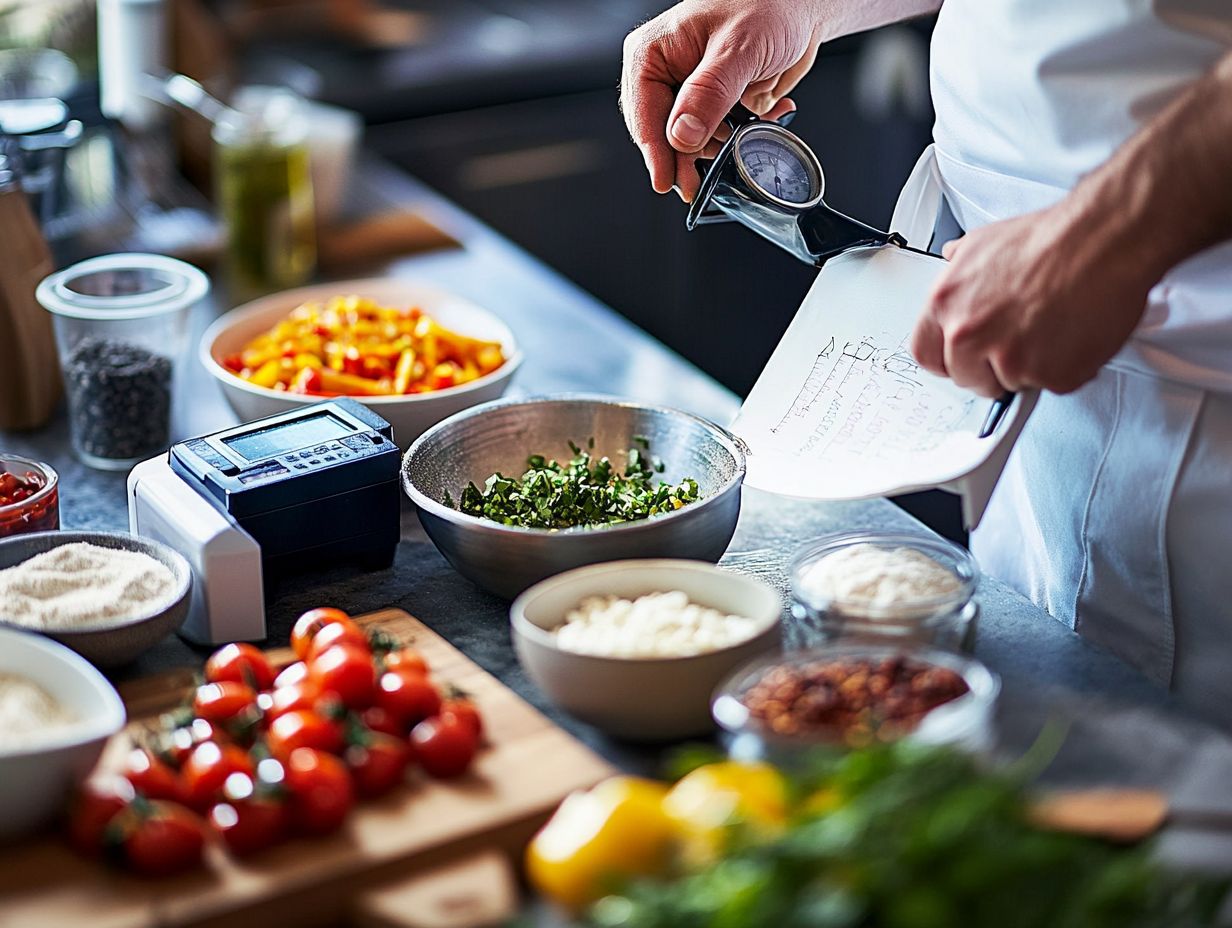
A damaged brand reputation stemming from inconsistent recipes can swiftly erode customer trust, making it increasingly difficult for you to maintain a competitive edge in the culinary marketplace.
When your patrons start questioning your restaurant’s consistency and quality, they may very well seek out competitors, leading to a decline in your loyal customer base. This downturn often results in severe financial implications, such as reduced revenue and the looming threat of layoffs. The road to recovery can be long and challenging; after all, no amount of marketing can substitute for the essential need for culinary excellence.
Restoring your restaurant’s reputation necessitates a renewed commitment to quality on your part, urging you to revisit your culinary techniques and source fresh ingredients to rebuild that all-important credibility. By prioritizing exceptional dishes that resonate with diners, you can gradually restore your reputation and regain the trust essential for continued success in this fiercely competitive industry. Utilizing advanced recipe management software can also help streamline processes and ensure effective recipe execution.
Call to Action: Assess your restaurant’s consistency and take proactive steps to improve your culinary offerings. Customers deserve the best, and your reputation depends on it!
4. Wasted Resources
Wasted resources from inconsistent recipes can inflate costs and reduce kitchen efficiency. This ultimately impacts your restaurant’s bottom line.
When chefs stray from standard procedures or overlook precise measurements, they often end up with unused ingredients that spoil or become obsolete. This escalates food costs and hampers overall productivity, as staff spends time managing inconsistencies instead of delivering service.
To alleviate the financial strain associated with ingredient waste, streamline your kitchen operations and foster a culture of accountability. Implementing rigorous training programs ensures that staff adheres to recipes consistently, which enhances your establishment’s profitability.
How To Improve Recipe Consistency?
You can enhance recipe consistency by using recipe management software, conducting regular recipe testing, and providing comprehensive staff training. This ensures that all kitchen operations adhere to established standards, elevating the quality of your culinary creations.
Leveraging digital distribution of recipes can improve recipe visibility and adherence across your team.
1. Use Recipe Management Software
Utilizing recipe management software enhances the digital distribution of recipes, improving visibility and accessibility. These elements are essential for maintaining consistency in your kitchen operations.
This software streamlines the recipe-sharing process, creating standardized recipes that everyone in your kitchen can easily follow. It boosts efficiency and guarantees that each dish meets the desired quality every time it’s prepared.
It also fosters better collaboration among your kitchen staff, enabling team members to communicate and share insights about the recipes in real-time. With features for precise ingredient measurements and detailed step-by-step instructions, this tool significantly reduces the risk of errors, helping you achieve culinary excellence in your fast-paced kitchen environment.
2. Conduct Recipe Testing and Feedback
Conducting regular recipe testing and seeking feedback from your kitchen staff are essential practices. They ensure consistency and uphold the cooking style within your restaurant.
These practices empower you to refine your dishes, adapt to seasonal ingredient changes, and maintain the high quality that diners expect. By actively soliciting insights from those who prepare the meals, you create a way to receive and give feedback that identifies areas for improvement and fosters a collaborative environment.
Addressing food allergies and customer dietary requests during testing can enhance the overall customer experience. This approach allows your culinary team to resolve issues quickly. It leads to a more cohesive dining experience.
Ultimately, your dedication to recipe testing and constructive feedback creates a standout menu that delights your patrons, reinforcing your restaurant’s reputation for excellence.
3. Train and Educate Your Staff
Training and educating your kitchen staff on precise recipe instructions and essential cooking techniques is crucial for achieving and maintaining recipe consistency.
By implementing comprehensive training programs, your culinary team can deepen their understanding of each step involved in preparing dishes. This approach not only ensures adherence to established recipes but also empowers them to refine their culinary skills.
The impact of this education on overall kitchen performance is significant, resulting in improved efficiency, reduced waste, and heightened customer satisfaction. When your staff is well-versed in both foundational and advanced cooking techniques, they become more adept at executing complex orders with confidence and precision.
Ongoing training cultivates a culture of teamwork and accountability, allowing kitchen personnel to feel supported in their roles. This ultimately elevates the dining experience for your patrons and sets a standard of excellence in your establishment.
Providing employee training on proper use of cooking utensils and recipe instructions further solidifies this commitment.
Continuously Monitor and Adjust Recipes
Stay ahead in the kitchen! Continuously monitoring and adjusting your recipes based on quality checks and food safety standards is vital for maintaining high performance and consistent output in your kitchen.
This practice allows you to accommodate various ingredient sources, which may fluctuate in flavor, texture, and nutritional content. As food trends shift, your responsiveness to customer preferences and feedback shapes your menu offerings, requiring flexibility from you and your kitchen team.
By actively engaging with these insights, you can fine-tune your recipes, enhancing both taste and presentation while ensuring safety. Such diligence not only provides a reliable dining experience but also strengthens your establishment’s reputation for quality, significantly reducing the risk of foodborne illnesses and ultimately fostering customer loyalty. Considering recipe alterations based on input from recipe developers and USDA guidelines can ensure recipe accuracy.
Frequently Asked Questions
Why is recipe consistency important?
Recipe consistency is important because it ensures that the same quality and taste of a dish is achieved every time it is made. This is especially crucial for commercial kitchens and restaurants to maintain their reputation, satisfy customers, and deliver high-quality meals that meet dietary requests.
What impact does kitchen efficiency have on recipe consistency?
Kitchen efficiency ensures that recipes are prepared quickly and correctly, which helps maintain consistency and meet customer expectations.
How does kitchen performance impact culinary excellence?
High kitchen performance directly contributes to culinary excellence by ensuring that recipes are prepared consistently and efficiently.
How does recipe visibility influence kitchen performance?
Recipe visibility ensures that all kitchen staff have access to the same recipes, which helps in maintaining consistency and improving kitchen performance.
What role do cooking utensils play in recipe consistency?
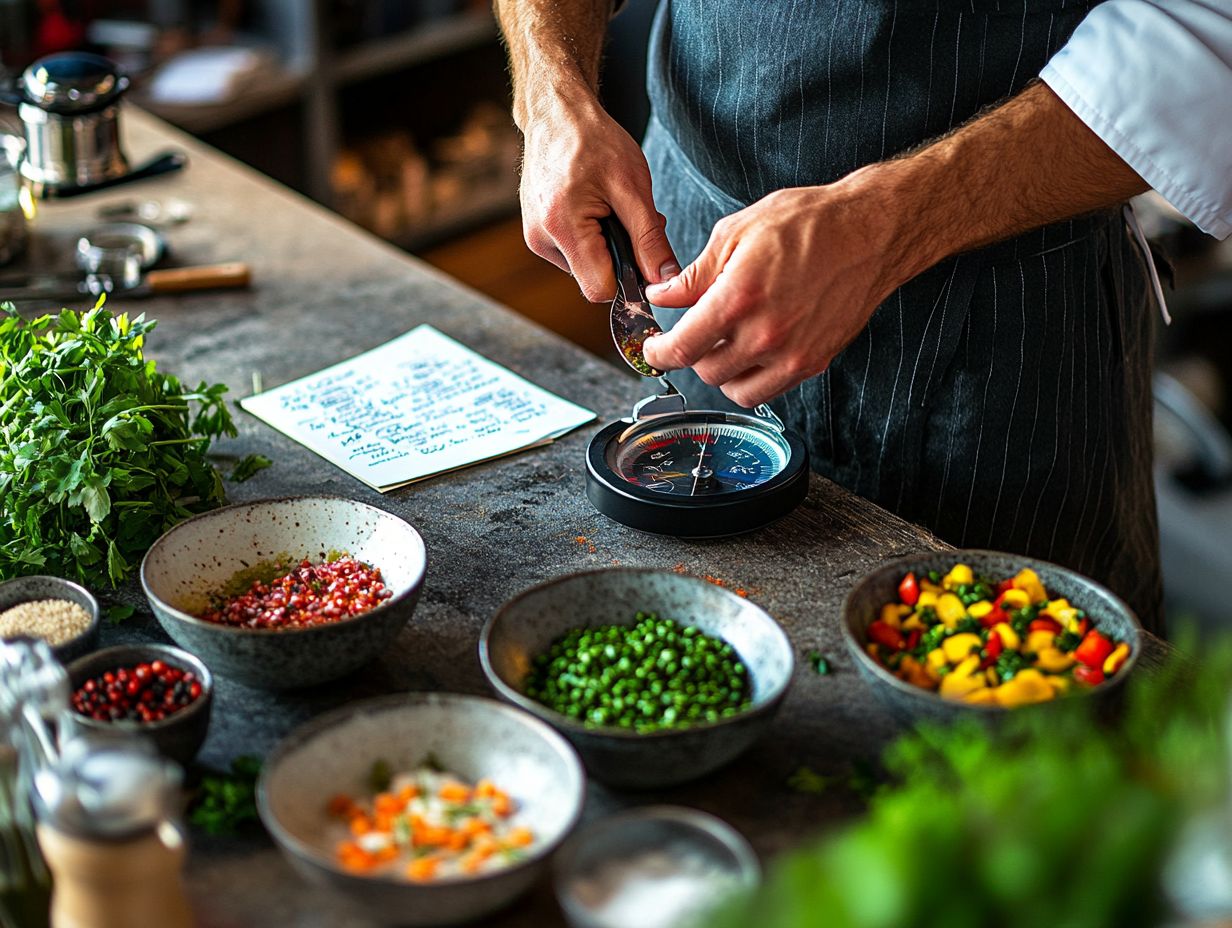
Using the correct cooking utensils can help maintain recipe consistency as they allow for precise measurements and cooking techniques.
How do ingredients affect recipe consistency?
Ingredient quality and consistency are crucial; using standardized ingredients ensures that the flavor profiles remain consistent across multiple preparations.
Can inconsistent recipes lead to food safety issues?
Yes, inconsistent recipes can lead to food safety issues as they may result in improper cooking times and temperatures. This can lead to food being undercooked or overcooked, which can harbor harmful bacteria that cause foodborne illnesses. Consistency in recipes is essential for food preparation to minimize these risks.
What measures can be taken to handle food allergies?
Handling food allergies requires strict adherence to standardized recipes and ingredient lists to avoid cross-contamination and ensure food safety.
How do portion sizes affect food safety?
Incorrect portion sizes can affect food safety by leading to improper cooking times, which may result in undercooked or overcooked food.
How important is employee training in maintaining recipe consistency?
Employee training is vital in maintaining recipe consistency, as properly trained staff are more likely to follow standardized recipes accurately, which is essential for food safety and quality.
How does recipe consistency affect cost and waste?
Effective recipe management is crucial in a foodservice operation to control costs, reduce waste, and ensure that high-quality meals are consistently produced.
How does recipe consistency impact customer experience?
Recipe consistency greatly impacts customer experience as it ensures that customers receive the same quality and taste every time they dine, leading to greater customer satisfaction.
What is the impact of portion size on recipe consistency?
Portion size directly impacts recipe consistency as it ensures that each meal served is uniform in quantity. This helps in managing ingredient quantities and recipe costs effectively.
Recipe consistency can greatly affect cost and waste in a kitchen. Inconsistent recipes can lead to over or under-portioning of ingredients, resulting in food waste and increased costs. This can also affect kitchen operations, inventory, and ordering practices, leading to additional expenses.
Proper recipe management can help in maintaining kitchen efficiency and reducing waste.
What factors can contribute to inconsistent recipes?
How do cooking techniques influence recipe consistency?
Consistent cooking techniques ensure that each dish is prepared in the same manner, which is crucial for maintaining recipe consistency.
Can inconsistent recipes lead to food safety issues?
What role do suppliers play in recipe consistency?
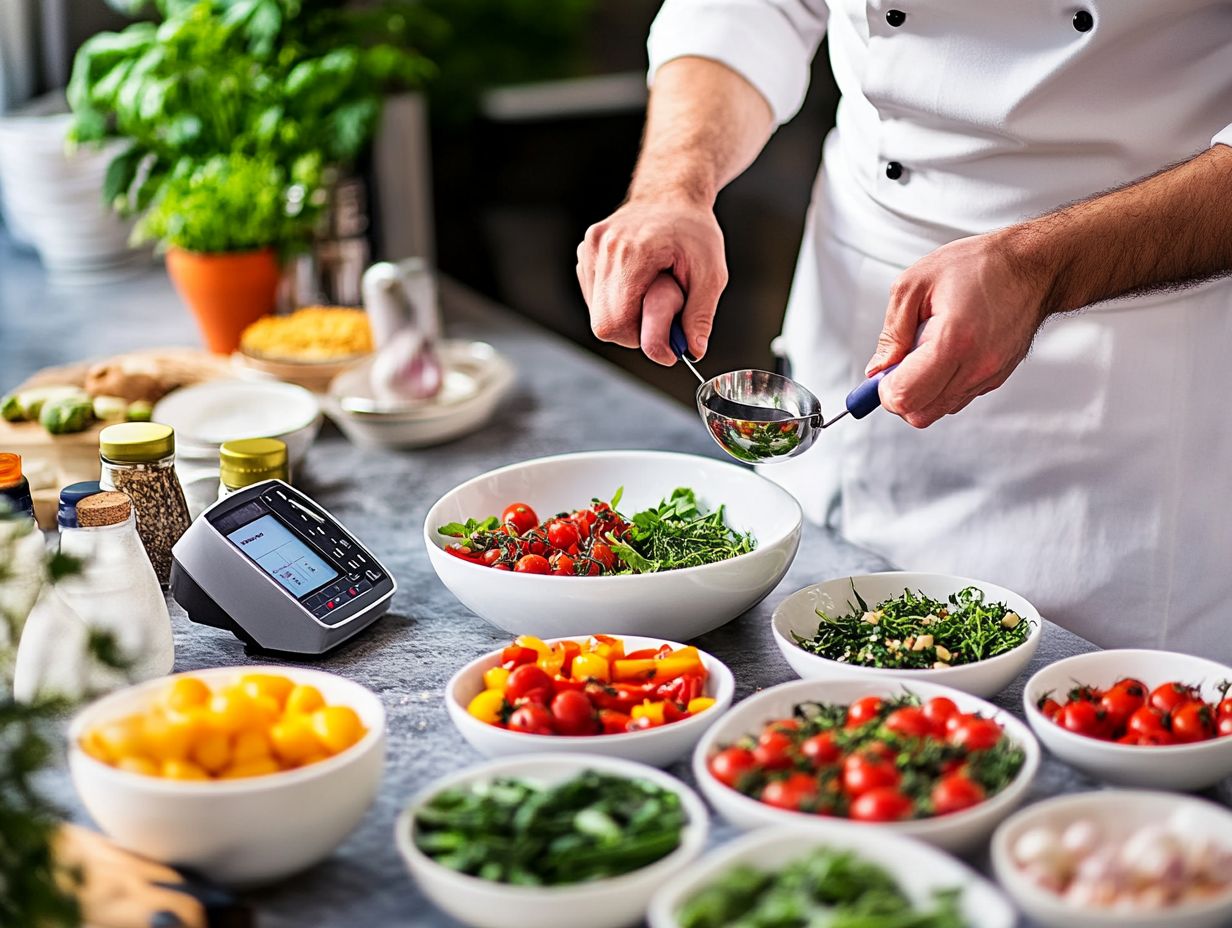
Suppliers play a significant role in recipe consistency by providing high-quality and consistent ingredients.
How do ingredient quantities affect recipe consistency?
Accurate ingredient quantities are essential to maintain recipe consistency, as variations can lead to changes in flavor and texture.
How do recipe components interact to influence consistency?
Each component of a recipe, from ingredients to cooking instructions, must be consistent to achieve a uniform final product. Variations in any of these components can lead to inconsistencies.
Are there software solutions to assist in recipe management?
Yes, recipe management software can assist in maintaining consistency by providing digital distribution of standardized recipes and monitoring recipe alterations.
Several factors can contribute to inconsistent recipes, such as human error, variations in ingredient measurements, and changes in cooking equipment or techniques. Using different brands or types of ingredients can also affect the consistency of a recipe. Proper training of kitchen staff and using standardized recipes can mitigate these issues.
How can recipe consistency be achieved?
What is the role of recipe instructions in maintaining consistency?
Clear and detailed recipe instructions ensure that each step of the recipe is followed accurately, which is essential for maintaining consistency.
What is the importance of regular recipe testing?
Regular recipe testing is not just important; it s essential to ensure the final product remains consistent and exceeds customer expectations! It helps identify any inconsistencies and allows for adjustments to be made, ensuring that the final product remains consistent and high-quality.
How do cooking instructions help in achieving consistency?
Clear and precise cooking instructions help ensure that every step of the preparation is followed accurately, leading to consistent results.
How do recipe developers contribute to consistency?
Recipe developers play a crucial role in ensuring consistency by creating detailed recipe instructions and conducting extensive recipe testing.
Recipe consistency can be achieved by following a standardized recipe, using precise measurements and cooking techniques. Ensuring all kitchen staff are properly trained is also essential. Regular taste testing and recipe adjustments can help maintain consistency. Implementing recipe management software can also aid in upholding these standards.
How do portion sizes affect quality experience?
Consistent portion sizes ensure that customers receive a uniform dining experience, contributing to a quality experience and customer satisfaction.
Recipe management ensures that all recipes comply with the menu standards, helping in maintaining consistency and quality across all dishes served.
What are the benefits of recipe management software?
Recipe management software empowers chefs by offering easy digital distribution of standardized recipes, ensuring consistency and quality in every dish!
What is the role of recipe accuracy in cooking culture?
Recipe accuracy is fundamental to cooking culture as it preserves the authenticity and quality of traditional dishes while meeting modern customer expectations.
How does the USDA impact food quality?
The USDA sets standards for food quality and safety that restaurants must comply with to ensure the food they serve is safe and high-quality.
How Can Culinary Excellence Be Maintained in a Foodservice Operation?
Strategies for Maintaining Culinary Excellence
Culinary excellence can be maintained by using effective recipes and ensuring recipe accuracy.
Maintaining a standard of food quality that meets customer expectations is crucial.
A consistent menu is essential for restaurants. It helps establish their brand and keeps customers coming back.
Disappointing customers with inconsistent recipes can lead to a loss of business.
Using a recipe checklist ensures accuracy and enhances the overall dining experience.

